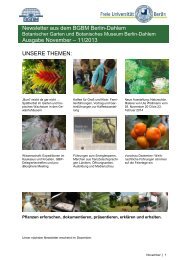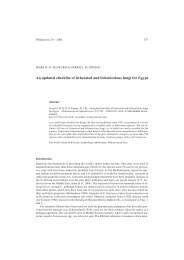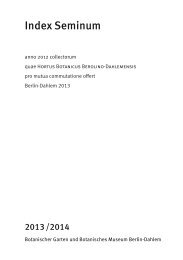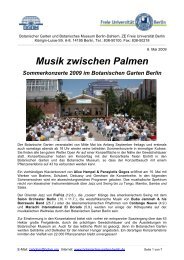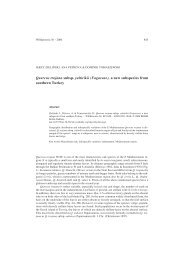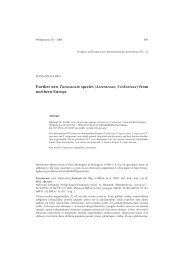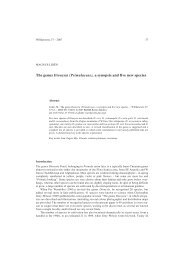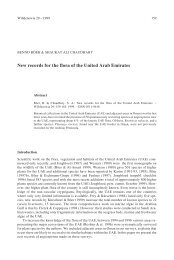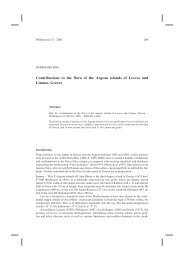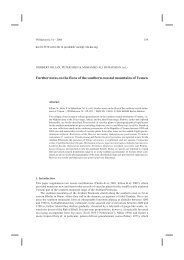Ausstellungskatalog - Botanischer Garten und Botanisches Museum ...
Ausstellungskatalog - Botanischer Garten und Botanisches Museum ...
Ausstellungskatalog - Botanischer Garten und Botanisches Museum ...
Sie wollen auch ein ePaper? Erhöhen Sie die Reichweite Ihrer Titel.
YUMPU macht aus Druck-PDFs automatisch weboptimierte ePaper, die Google liebt.
Forschen 1910 – 2010 · Research 1910 – 2010<br />
Zwei Gründe können angeführt werden, um die nur<br />
langsam ansteigende Zahl von Publikationen in den ersten<br />
drei Jahrzehnten nach Kriegsende zu erklären: der im<br />
internationalen Vergleich immer zu kleine Stab an Wissenschaftlern<br />
<strong>und</strong> deren vielfache Beanspruchung durch den<br />
Wiederaufbau der sehr großen <strong>und</strong> komplexen Einrichtung.<br />
Im Botanischen <strong>Garten</strong> <strong>und</strong> Botanischen <strong>Museum</strong><br />
seitdem erarbeitete Monographien, etwa von altweltlich<br />
verbreiteten Korbblütlergattungen (z. B. Launaea), fanden<br />
hohe Anerkennung. Ähnliches gilt für eine Gesamtdarstellung<br />
der neuweltlichen Kakteengattung Pereskia <strong>und</strong> eine<br />
in Abschnitten erschienene weltweite Revision der pantropischen<br />
Familie Opiliaceae. HWL<br />
Taxonomic Projects<br />
The principle of research freedom on the one hand, and the pressure<br />
towards ever greater specialisation and the lack of regional projects<br />
on the other led, after the Second World War, to several research<br />
121<br />
projects that were focussed on single genera or families with out geographical<br />
restriction. The establishment of clearly defined research<br />
foci was at that time unusual, and many plant groups could only<br />
be worked on intermittently. The second largest flowering plant<br />
family, the daisies (Asteraceae), were not for example studied until<br />
the 1950s and then again from 1975, while work on other large<br />
groups also exhibited similar discontinuities.<br />
Two reasons can be adduced to explain the only slowly increasing<br />
number of publications in the first three decades following<br />
the end of the war: first, the ever insufficient staff of scientists<br />
in comparison with other institutions internationally and second,<br />
the multiple demands on the staff due to the reconstruction of the<br />
very large and complex institution. Monographs produced since<br />
then in the Botanic Garden and Botanical <strong>Museum</strong>, of Old World<br />
daisy genera for example (e. g. Launaea), met with great approval.<br />
The same is true for a complete overview of the New World cactus<br />
genus Pereskia, and a worldwide review of the pan-tropical family<br />
Opiliaceae, which was published in instalments. HWL<br />
Verbreitung des Laubmooses Mitthyridium fascicularum<br />
auf Basis von ausgewerteten Herbarbelegen in Sammlungen<br />
weltweit. Aus: H. Nowak, Revison der Laubmoosgattung<br />
Mitthyridium (Mitten) Robinson für Ozeanien<br />
(Calymperaceae), Bryophytorum Bibliotheca 20,<br />
Vaduz 1980: 110.






